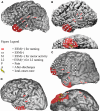Language mapping in multilingual patients: electrocorticography and cortical stimulation during naming
- PMID: 21373361
- PMCID: PMC3044479
- DOI: 10.3389/fnhum.2011.00013
Language mapping in multilingual patients: electrocorticography and cortical stimulation during naming
Abstract
Multilingual patients pose a unique challenge when planning epilepsy surgery near language cortex because the cortical representations of each language may be distinct. These distinctions may not be evident with routine electrocortical stimulation mapping (ESM). Electrocorticography (ECoG) has recently been used to detect task-related spectral perturbations associated with functional brain activation. We hypothesized that using broadband high gamma augmentation (HGA, 60-150 Hz) as an index of cortical activation, ECoG would complement ESM in discriminating the cortical representations of first (L1) and second (L2) languages. We studied four adult patients for whom English was a second language, in whom subdural electrodes (a total of 358) were implanted to guide epilepsy surgery. Patients underwent ECoG recordings and ESM while performing the same visual object naming task in L1 and L2. In three of four patients, ECoG found sites activated during naming in one language but not the other. These language-specific sites were not identified using ESM. In addition, ECoG HGA was observed at more sites during L2 versus L1 naming in two patients, suggesting that L2 processing required additional cortical resources compared to L1 processing in these individuals. Post-operative language deficits were identified in three patients (one in L2 only). These deficits were predicted by ECoG spectral mapping but not by ESM. These results suggest that pre-surgical mapping should include evaluation of all utilized languages to avoid post-operative functional deficits. Finally, this study suggests that ECoG spectral mapping may potentially complement the results of ESM of language.
Keywords: ECoG; electrocortical stimulation mapping; electrocorticography; epilepsy surgery; functional mapping; high gamma; multilingual; naming.
Figures



Similar articles
-
Electrocorticographic high gamma activity versus electrical cortical stimulation mapping of naming.Brain. 2005 Jul;128(Pt 7):1556-70. doi: 10.1093/brain/awh491. Epub 2005 Apr 7. Brain. 2005. PMID: 15817517
-
Mismatch between electrocortical stimulation and electrocorticography frequency mapping of language.Brain Stimul. 2013 Jul;6(4):524-31. doi: 10.1016/j.brs.2013.01.001. Epub 2013 Jan 29. Brain Stimul. 2013. PMID: 23395595
-
Recording human electrocorticographic (ECoG) signals for neuroscientific research and real-time functional cortical mapping.J Vis Exp. 2012 Jun 26;(64):3993. doi: 10.3791/3993. J Vis Exp. 2012. PMID: 22782131 Free PMC article.
-
High-frequency gamma oscillations and human brain mapping with electrocorticography.Prog Brain Res. 2006;159:275-95. doi: 10.1016/S0079-6123(06)59019-3. Prog Brain Res. 2006. PMID: 17071238 Review.
-
The changing landscape of electrical stimulation language mapping with subdural electrodes and stereoelectroencephalography for pediatric epilepsy: A literature review and commentary.Epilepsia. 2024 Jul;65(7):1879-1898. doi: 10.1111/epi.18009. Epub 2024 May 24. Epilepsia. 2024. PMID: 38787551 Review.
Cited by
-
Language Assessment in Multilingualism and Awake Neurosurgery.Front Hum Neurosci. 2021 Nov 25;15:750013. doi: 10.3389/fnhum.2021.750013. eCollection 2021. Front Hum Neurosci. 2021. PMID: 34899217 Free PMC article. Review.
-
Potential differences between monolingual and bilingual patients in approach and outcome after awake brain surgery.J Neurooncol. 2020 Jul;148(3):587-598. doi: 10.1007/s11060-020-03554-0. Epub 2020 Jun 10. J Neurooncol. 2020. PMID: 32524393 Free PMC article.
-
Visualization of functional and effective connectivity underlying auditory descriptive naming.Clin Neurophysiol. 2025 Jul;175:2010729. doi: 10.1016/j.clinph.2025.04.008. Epub 2025 Apr 21. Clin Neurophysiol. 2025. PMID: 40349545
-
Cortical high-gamma responses in auditory processing.Am J Audiol. 2011 Dec;20(2):171-80. doi: 10.1044/1059-0889(2011/10-0036). Am J Audiol. 2011. PMID: 22158634 Free PMC article. Review.
-
Can bilingualism increase neuroplasticity of language networks in epilepsy?Epilepsy Res. 2022 May;182:106893. doi: 10.1016/j.eplepsyres.2022.106893. Epub 2022 Mar 4. Epilepsy Res. 2022. PMID: 35278806 Free PMC article.
References
-
- Abutalebi J. (2008). Neural aspects of second language representation and language control. Acta Psychol. (Amst.) 128, 466–478 - PubMed
-
- Anderson J. M., Gilmore R., Roper S., Crosson B., Bauer R. M., Nadeau S., Beversdorf D. Q., Cibula J., Rogish M., 3rd, Kortencamp S., Hughes J. D., Gonzalez Rothi L. J., Heilman K. M. (1999). Conduction aphasia and the arcuate fasciculus: a reexamination of the Wernicke–Geschwind model. Brain Lang. 70, 1–1210.1006/brln.1999.2135 - DOI - PubMed
Grants and funding
LinkOut - more resources
Full Text Sources

